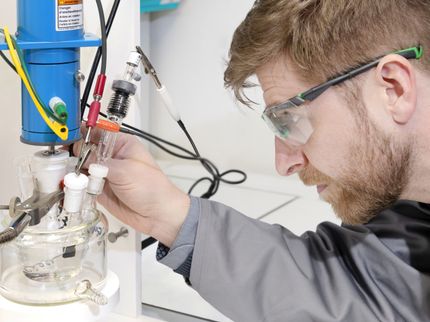Extracting energy from bacteria
Most of us wouldn't consider bacteria a promising energy source of the future. That would be shortsighted, says Leonard Tender, a microbial-electrochemist at the Naval Research Laboratory in Washington, D.C., who believes that the focus of his research – electrode reactions catalyzed by microorganisms – may one day provide cheap, clean and abundant energy by converting the carbon dioxide in seawater to fuel and the organic matter in wastewater into electrical power.
Dissimilatory metal-reducing bacteria (DRMB) are a fascinating group of microorganisms inhabiting a wide variety of environments including marine sediments and sewage. Tender says that DRMBs acquire energy by coupling oxidation of – and the accompanying loss of electrons by – organic material with reduction of – and the gain of electrons by – insoluble oxidants such as mineral deposits. This ability, he explains, requires the bacteria to transport respired (lost) electrons to their outer surface where they become available for transfer to the insoluble oxidant. The process, known as extracellular electron transfer (EET), has been exploited by Tender and others to create a biological anode catalysts.
"For example, we can grow Geobacter sulfurreducens, a common DRMB, as a multi-cell thick biofilm on the surface of an electrode," Tender says. "Electrons are then transported by EET from the cells through the biofilm to the underlying anode surface of the electrode which results in the generation of electric current."
Just how electrons are transported through the biofilm to the anode surface over distances that can exceed 20 microns remains unsolved, Tender says. "Current evidence suggests that it occurs by incoherent multistep 'electron hopping' across a network of immobile cytochromes at the outer membrane or extracellular region, and not surprisingly, G. sulfurreducens expresses these cytochromes in both locations," he says. "We are currently studying the rate of electron flow through biofilms grown across a gap separating two electrodes—a method known as electrochemical gate measurement—and using Raman spectroscopy to monitor the oxidation state of the cytochromes in the biofilms to see if the electron hopping model is validated."
So far, Tender reports, the data indicate yes. "Our gate measurements reveal a set of highly resolved peaks in plots of current through the biofilms vs. potentials applied to the electrode representing indicative of a electron hopping from cytochrome to cytochrome," he says.
If microbial electrode catalysts can be successfully implemented in the future, Tender says, the payoff would be the ability to generate unlimited amounts of energy from the carbon dioxide in seawater and sunlight. "In theory, it could be done by using an electrode to supply electrons to a microbial biofilm that reduces CO2 to organic carbon," he says. "Once can imagine a large refinery that is solar powered, sucks in seawater or sewage, and makes fuel or electricity."
"In fact, we believe that as long as a marine or wastewater environment can continuously supply the organic material and the oxidant to the MEC, it could run almost endlessly," Tender says.
Other news from the department science
Most read news
More news from our other portals
See the theme worlds for related content
Topic World Spectroscopy
Investigation with spectroscopy gives us unique insights into the composition and structure of materials. From UV-Vis spectroscopy to infrared and Raman spectroscopy to fluorescence and atomic absorption spectroscopy, spectroscopy offers us a wide range of analytical techniques to precisely characterize substances. Immerse yourself in the fascinating world of spectroscopy!

Topic World Spectroscopy
Investigation with spectroscopy gives us unique insights into the composition and structure of materials. From UV-Vis spectroscopy to infrared and Raman spectroscopy to fluorescence and atomic absorption spectroscopy, spectroscopy offers us a wide range of analytical techniques to precisely characterize substances. Immerse yourself in the fascinating world of spectroscopy!






























































